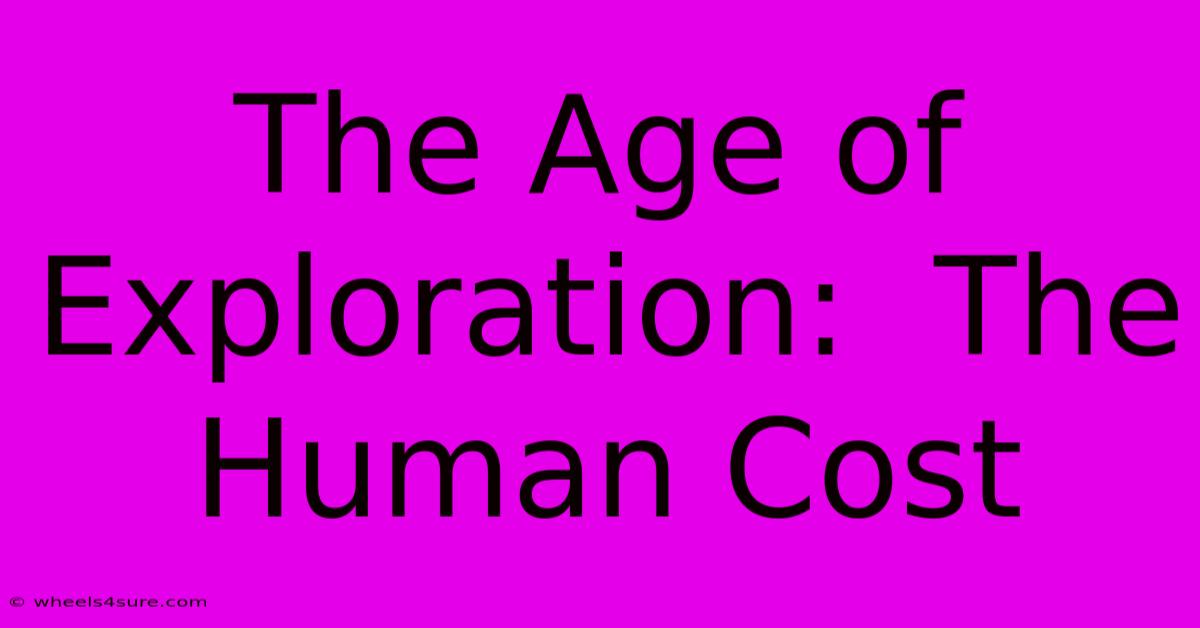The Age Of Exploration: The Human Cost

Table of Contents
The Age of Exploration: The Human Cost
The Age of Exploration, a period spanning roughly from the 15th to the 17th centuries, is often romanticized as a time of daring voyages, groundbreaking discoveries, and the expansion of European influence across the globe. However, beneath the veneer of adventure lies a brutal reality: a staggering human cost paid by indigenous populations and the sailors who embarked on these perilous journeys. This article delves into the devastating consequences of European exploration, revealing a darker side often overlooked in traditional narratives.
The Devastation of Indigenous Populations
The impact of European arrival on indigenous populations was catastrophic. Disease, violence, and enslavement decimated entire societies, fundamentally altering the course of history for countless communities.
The Scourge of Disease
Perhaps the most insidious weapon wielded by Europeans was unintentional: disease. Smallpox, measles, influenza, and other illnesses, to which Europeans had developed some immunity, ravaged indigenous populations who lacked any natural resistance. These epidemics wiped out vast swathes of the population, leaving societal structures shattered and paving the way for easier conquest. Entire civilizations were decimated, their knowledge, cultures, and traditions lost forever. The demographic collapse caused by disease is arguably the single biggest factor in the human cost of exploration.
Violence and Conquest
Beyond disease, the Age of Exploration was characterized by widespread violence and conquest. European powers, driven by the pursuit of resources and land, engaged in brutal campaigns of subjugation, often employing superior weaponry and tactics to overwhelm indigenous defenses. Massacres, forced labor, and the destruction of cultural artifacts were commonplace, resulting in immense suffering and the disruption of traditional ways of life. The systematic oppression and violence inflicted upon indigenous people continue to resonate today.
The Transatlantic Slave Trade
The transatlantic slave trade, inextricably linked to the Age of Exploration, represents one of history's greatest atrocities. Millions of Africans were forcibly abducted from their homes, subjected to horrific conditions during the Middle Passage, and then enslaved in the Americas. The physical and emotional toll on these individuals and their descendants is immeasurable, creating a legacy of trauma that persists to this day. This brutal system fueled the economies of European colonial powers and left an indelible stain on the history of the world.
The Hardships Faced by European Sailors
While the suffering of indigenous populations was undeniably immense, the lives of European sailors were far from idyllic. The voyages were incredibly dangerous, characterized by:
Perilous Journeys and Harsh Conditions
Sea voyages during this era were arduous and fraught with peril. Sailors faced the constant threat of storms, scurvy (a vitamin C deficiency), starvation, and disease. Living conditions aboard ships were cramped and unsanitary, leading to the rapid spread of illness. Many sailors perished at sea, never reaching their destination.
Brutality and Violence
Discipline aboard ships was often brutal, with harsh punishments meted out for even minor infractions. Mutiny was a constant threat, and the potential for violence between crew members was ever-present. The psychological strain of prolonged voyages, coupled with the harsh realities of life at sea, took a heavy toll on the mental and physical well-being of sailors.
Exploitation and Inequality
The hierarchical structure of ships often led to the exploitation of lower-ranking crew members. Sailors faced long hours of grueling labor with little reward, and their lives were often expendable in the pursuit of colonial ambitions. The economic inequalities of the time amplified the hardships faced by many sailors.
A Legacy of Injustice
The Age of Exploration left a complex and deeply troubling legacy. While it undeniably led to significant advancements in navigation and cartography, and facilitated the exchange of goods and ideas, these achievements were built on a foundation of exploitation, violence, and immense human suffering. Understanding the human cost of this era is crucial to fostering a more nuanced and accurate understanding of world history and to grappling with the ongoing consequences of colonialism. It's a vital step in working towards a more just and equitable future. Further research into primary sources, including ship logs, indigenous accounts, and colonial records, provides a deeper insight into the realities of this transformative and devastating period.

Thank you for visiting our website wich cover about The Age Of Exploration: The Human Cost. We hope the information provided has been useful to you. Feel free to contact us if you have any questions or need further assistance. See you next time and dont miss to bookmark.
Featured Posts
-
Unexpected Alliances The Fight Against The Evil Bride
Apr 05, 2025
-
David Beckhams Daughters Academic Achievements
Apr 05, 2025
-
Emmy Rossums Daughter A Future Leader
Apr 05, 2025
-
Beyond The Years Kareena Kapoors Age And Enduring Success
Apr 05, 2025
-
Kim Sae Rons Age More Than Just A Number
Apr 05, 2025
